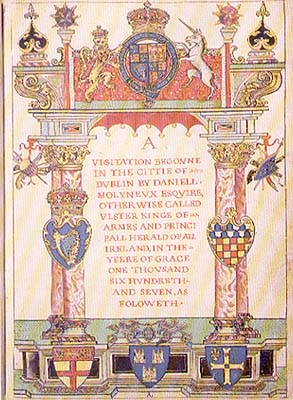An heraldic primer - part 7
 Visitations—an
early effort to regularise English heraldry Visitations—an
early effort to regularise English heraldry
Visitations were conducted under the authority of Henry
VIII by Letters Patent in 1530 and continued through to
1686 to verify the validity of arms being borne at the time.
Local authorities under instructions from the county sheriff
were required to prepare lists of nobles, knights and other
gentlefolk who were interviewed by the heralds to ascertain
their entitlement to the arms they were displaying. As evidence
the bearers of arms presented verbal and documentary evidence
that was duly noted by the heralds and often basic pedigrees
were developed as provenance to long use or a grant of arms.
All surviving records are held by the College of Heralds
in London. Many family researchers who manage to extend
their history back to this era are fortunate to find they
link into such records which may take their research back
in time a few more generations in a period when documentation
is very scarce indeed.
The problem the researcher will inevitably face is that
there is little chance of confirming the accuracy of the
material as there is evidence that some so-called authenticated
pedigrees signed by the representative of the family and
retained by the College of Arms were largely fictional!
This is nothing new as the trade in false pedigrees to gain
social status has been rife for generations and we always
need to be alert to this fact.
Many spurious pedigrees were produced for a fee and heralds
were on occasion imprisoned for granting arms to base-born
individuals. William Dethick (1587–1606 Clarenceux
King of Arms) was criticized for making grants to persons
who were thought to be too inferior, including a Stratford
glover named John Shakespeare whose son William influenced
the grant and thus become born of gentry!
| John Shakespeare made his first
unsuccessful application to the College of Heralds in
1576, when William was twelve. In 1596, with the help
of his now quite wealthy son his third application was
successful. The only thing wrong with the claim was
he probably was not worth £500 and he did not
have an ancestor who fought with Henry VII and won lands
in Warwickshire. Shield… or, on a bend sable a
spear of the first steeled argent; crest... a falcon
wings displayed argent, standing on a torse of his colours
supporting a spear or, steeled as aforesaid; motto…
non sanz droict. |
|
A comprehensive guide with one of the longest titles in
any library by Cecil Humphery-Smith, Armigerous Ancestors:
a catalogue of sources for the study of the Visitations
of the Heralds in the 16th and 17th centuries with referenced
lists of names, stresses the usefulness of the records
of the herald's visitations. The writer suggests the material
might provide the vital clue in establishing links at a
time when there are serious problems with other sources
because of the English Civil War, missing records, and the
like. It is also pointed out that the visitations also deal
with a greater cross-section of people than may be realised.
Climbing the social ladder and tumbling down again was quite
common and the disclaimers of those whose pedigrees were
not authenticated include all sorts of people. This book
lists every name that appears in the visitations of the
sixteenth and seventeenth centuries and indicates which
published volumes need to be consulted for each name.
The many volumes of visitations as published by the Harleian
Society and others are becoming more available to us
in South Australia with some volumes on ancestry.co.uk
databases. This last resource makes it very easy to search
across multiple volumes all at once. Presently the counties
of Cumberland, Devonshire, Lancashire, Nottinghamshire,
Oxfordshire, Somerset, and Warwickshire are available.
Reference:
Humphery-Smith, Cecil R; Armigerous Ancestors: a catalogue
of sources for the study of the Visitations of the Heralds
in the 16th and 17th centuries with referenced lists of
names, 1997.
Graham Jaunay BA DipT MACE AAGRA
Originally published as a series in, Relative Thoughts,
Fleurieu Peninsula Family History Group
|